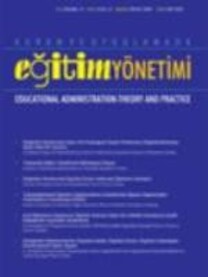Sınıf İçi Öğretmen Davranışları Ölçeğinin Geliştirilmesi: Geçerlik ve Güvenirlik Analizleri
Bu araştırmanın amacı, sınıf içi öğretmen davranışlarını belirlemede kullanılacak geçerlik ve güvenirlik düzeyi yüksek bir ölçme aracı geliştirmektir. Ayrıca, sınıf içi öğretmen davranışları ile cinsiyet ve kadro değişkenleri arasındaki ilişki incelenmiştir. Çalışma grubu, katılımda gönüllü olan 101 ilköğretim öğretmeni ile 190 lise öğretmeninden oluşmuştur. 10 öğretmen ise branşını belirtmemiştir. Kapsam geçerliği için ölçekte yer alan 46 sorunun öğretmen davranışlarını örneklemedeki yeterliği ve amaca uygunluğunu incelemek amacıyla yedi uzmandan, Likert tipi beşli derecelendirme ölçeği kullanılarak görüş alınmıştır. Uzman değerlendirmesine göre amaca uygun olmayan dokuz madde taslak formdan çıkartılmıştır. SÖDÖ'nin yapı geçerliği, faktör yapısı, açımlayıcı faktör analizi (AFA, exploratory factor analysis) ile incelenmiştir. Ölçekte yer alan 22 maddenin birinci faktör yükünün .45 üzerinde olması ve kalan beş maddenin de .36 ve üzerinde yük değeri vermesi ölçeğin tek faktörlü olduğunu desteklemektedir. Ölçeğin AFA ile belirlenen faktör yapısının, modelin, verilerle ne derece uyum gösterdiğini belirlemek için doğrulayıcı faktör analizi (DFA, confirmatory factor analysis) yapılmıştır. DFA sonucu, verilerle modelin uyumlu olduğunu göstermektedir. Ölçeğin güvenirliği için Cronbach Alfa katsayısı (.904) ve Spearman Brown korelasyonu (.836) hesaplanmıştır. Ölçeğin zamana bağlı tutarlı ölçümler verip vermediğini incelemek amacıyla test tekrar test korelasyonuna bakılmış ve güvenirliği .84 olarak bulunmuştur. Analiz sonuçları, 27 maddeden oluşan SÖDÖ'nin tek faktörlü geçerlik ve güvenirlik düzeyi yüksek bir ölçek olduğunu; öğretmen davranışları arasında cinsiyet ve kadroya göre anlamlı farkların olduğunu göstermiştir.
Anahtar Kelimeler:
öğrenci merkezli , öğretmen merkezli , öğretmen davranışları
Development of Teacher Behaviors Within Classroom Scale: Validity and Reliability Analysis
The purpose of this research is to develop a valid and reliable measurement tool to determine teacher behaviors within classroom. In addition, the relationship between teachers' behavior and a) gender, and b) profession (classroom teachers or subject matter teachers) variables are examined. 301 teachers participated in this research. Voluntary participants were 101 primary school teachers and 190 secondary school teachers working in different cities. 10 teachers didn't state his/her profession.To provide content validity, the draft form of the scale with 46 items was examined by seven experts on the 5 point Likert Scale. According to experts evaluations, 9 items that were not suitable for the aim of scale were extracted besides pilot survey with 37 items was formed and called as TBCS (Teacher Behaviors Within Classroom Scale). The construct validity of TBCS was examined with EFA (exploratory factor analysis). Factor loadings of 22 items of the scale were greater than .45 and factor loadings of remaining 5 items were greater than .35. This result supported that the scale has one factor.To determine the degree of factor structure fiting with data, DFA (confirmatory factor analysis) was done by Lisrel 8.30 statistic software. The result was .028, so one factorial scale structure fits with the data. For reliability of the scale, Cronbach Alpha coefficient and Spearman Brown splithalf correlation were computed. Cronbach Alpha coefficient was .904 (.893 for the first half, and .911 for the second half). Spearman Brown correlation computed as .836 (.805 for the first half, and .856 for the second half). To estimate the stability of measure over time, testretest correlation was examined and computed as .84. The results of the analysis showed that the scale which has 27 items was reliable and valid with one factor. Also there was a statistically significant difference between teachers' behaviors and gender, and profession.
Keywords:
learner centered , teacher centered , teacher behaviors,
- ISSN: 1300-4832
- Yayın Aralığı: Yılda 4 Sayı
- Başlangıç: 1995
- Yayıncı: Pegem Akademi Yayıncılık Eğitim Danışmanlık Hizmetleri Tic. Ltd. Şti.
Sayıdaki Diğer Makaleler
Sınıf Öğretmenlerine Göre Hoşgörü
İlköğretim Okul Müdürlerinin Yönetsel Görevlere Ayırdıkları Zaman ve Bunları Önemli Görme Dereceleri
Cengiz AKÇAY, Mustafa Aydın BAŞAR
Göreve Yeni Başlayan Sınıf Öğretmenlerinin Karşılaştıkları Güçlükler
İsa KORKMAZ, Ahmet ŞABAN, SAİT AKBAŞLI
Sınıf İçi Öğretmen Davranışları Ölçeğinin Geliştirilmesi: Geçerlik ve Güvenirlik Analizleri
Şener BÜYÜKÖZTÜRK, Ebru KILIÇ, Şirin KARADENİZ, SERÇİN KARATAŞ
Eğitim Düzeyi İle Suç Türü Arasındaki İlişkinin Araştırılması
